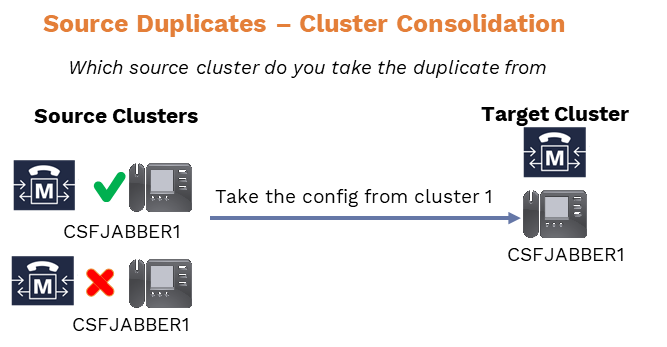Migration Factory - Part 5 – WxC-DI Advanced Migration Features: Cluster Consolidation and Phased Migration
As we continue our journey through the process of migrating to Webex Calling Dedicated Instance (WxC-DI), it is time to delve into some of the advanced migration features offered by the wrangler suite. In this fourth installment, we will explore how to leverage wrangler_'s advanced capabilities for cluster consolidation and phased migration. These tools are especially valuable for large and complex customers who need to migrate over extended durations or consolidate multiple clusters into a single target cluster.
Cluster Consolidation: Simplifying Complex Environments
Cluster consolidation is a potent feature when dealing with multiple source clusters, particularly in large organizations. The aim here is to merge these disparate clusters into a single, cohesive target cluster within the WxC-DI environment.
wrangler_'s advanced features make it possible to simplify the process by mapping multiple source clusters to a single target cluster. This process reduces complexity, enhances system efficiency, and cuts down on the administrative overhead associated with managing multiple clusters.
Phased Migration: Minimizing Disruption
Phased migration, another advanced feature offered by wrangler_, is designed to help organizations manage the migration process with minimal disruption to their operations. Rather than migrating all data at once, this approach allows you to execute the migration in carefully planned stages.
The phased migration process introduces additional steps to the standard migration process. After creating sites and re-running the allocation process, sites must be grouped. Each site group is then migrated as a batch. To identify any inter-site dependencies before migrating the first site, the inter-site dependency report is run against each site group. Dependencies that are identified will require adjustment, either by pulling the configuration into this migration batch by adjusting the SiteId or by cutting the configuration so that there is no dependency, which can be reconnected when the dependency migrates.
This strategy is especially useful for larger organizations with complex environments, as it allows for careful planning and execution of the migration, minimizing the risk of issues arising during the process.
Duplicate Management in Cluster Consolidation
One of the challenges of cluster consolidation is the management of duplicates. wrangler_ includes robust features to handle duplicates, both within the source clusters and between the source and target environments.
Source Duplicates
In a cluster consolidation scenario, the same configuration elements may be present in multiple clusters. These duplicates need to be identified and managed to avoid conflicts during the consolidation process.
wrangler_'s discovery process plays an essential role in this regard. During the discovery phase, wrangler_ identifies and lists all configuration elements in the source clusters. This includes devices, lines, and users, among other elements. By analyzing this data, wrangler_ can identify duplicates within the source clusters.
Once duplicates are identified, wrangler_ provides options to handle them. For example, the Bulk Change feature can be used to adjust the configuration settings of the duplicates, or they can be ignored altogether. Alternatively, default configurations can be set for the duplicates, ensuring they are handled consistently during the migration process.
Target Duplicates
Duplicates can also arise between the source and target environments during migration. These duplicates need to be managed to ensure that the migrated configuration elements do not conflict with existing elements in the target environment.
Again, wrangler_ includes features to handle this scenario. During the Prepare/Clone Step, objects are cloned or transformed and staged for load. If any duplicates are identified during this process, wrangler_ will flag them for review.
The Load Step includes further checks for duplicates. During this step, all staged objects are added to the target servers. If any duplicates are identified, wrangler_ can either update the existing target objects or create new ones, depending on the specified requirements.
The ability to manage duplicates is one of the many ways that wrangler_ simplifies the process of cluster consolidation. With its robust suite of features, wrangler_ ensures that the migration process is smooth and efficient, regardless of the complexity of the source or target environments.
Dial Plan Verification and Configuration Reports
Ensuring that the dial plan is correctly configured and functions as expected is vital. Wrangler offers a Dial Plan Verification feature that uses the dialling forest to ensure all patterns are present. Additionally, it provides configuration reports listing calling search spaces usage, orphaned objects, and step changes. These tools help to verify that the migrated system will function as expected, and any issues can be addressed before they become problems.
The Role of Validation in Cluster Consolidation
Validation plays a crucial role in the consolidation process. wrangler_ conducts pre-load validation, ensuring that there are no configuration or settings errors that could obstruct the load into the target. This involves a sequencing check and a review of object configuration or settings. If any dependent objects are identified during this process, wrangler_ provides options for their migration as well.
Wrangler Calling Dedicate Instance WxC-DI Deep Dive Training 1h45min
Try out wrangler_ using Cisco dCloud labs on demand
Note: that the wrangler_ lab is availible in multiple geographies other than US(RTP)
Now that we have covered wrangler_ for Webex Calling Dedicated Instance (WxC-DI) now we can focus testing in the next part


